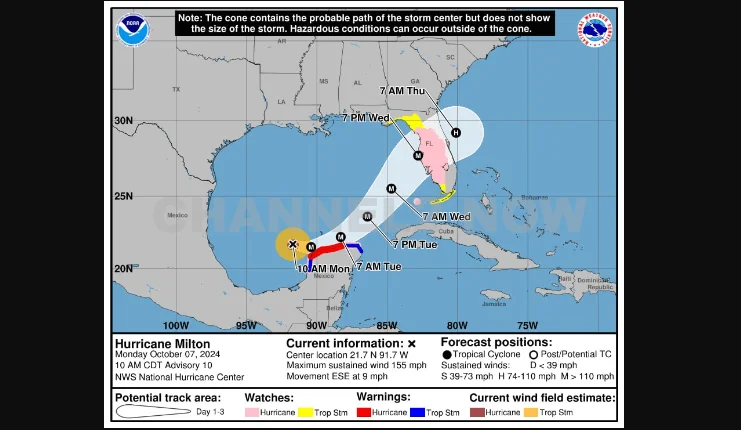
Hurricane Milton Expected to Become a Category 5 Storm: Immediate Preparations Urged for Residents in the Northern Yucatán Peninsula, Including Mérida and Cancún, as Winds Intensify by 90 MPH in 24 Hours
Hurricane Milton Expected to Become a Category 5 Storm: Immediate Preparations Urged for Residents in the Northern Yucatán Peninsula, Including Mérida and Cancún, as Winds Intensify by 90 MPH in 24 Hours
Hurricane Milton, a powerful storm brewing in the Caribbean, is on the cusp of being classified as a Category 5 hurricane, a designation that signifies extremely dangerous conditions. As of today, October 7, 2024, meteorologists are urging residents along the northern Yucatán Peninsula—particularly in cities such as Mérida and Cancún—to finalize their preparations as the storm threatens to unleash severe impacts when it passes just offshore.
The National Hurricane Center has reported that Hurricane Milton has undergone rapid intensification, with wind speeds increasing by an astonishing 90 miles per hour in just 24 hours. This rapid escalation in strength is reminiscent of the extreme behavior exhibited by record-breaking hurricanes Wilma in 2005 and Felix in 2007, both of which inflicted significant damage and loss of life in the region.
As Milton continues its trajectory, residents are urged to take immediate action to secure their homes, gather emergency supplies, and remain informed about the storm’s path through official channels. Authorities have emphasized that safety measures should be prioritized, as the potential for life-threatening conditions grows with each passing hour.
The forecast indicates that Hurricane Milton is projected to become the second Category 5 hurricane of the 2024 hurricane season, joining the ranks of storms that have historically wreaked havoc on the Yucatán Peninsula. With meteorological models predicting that the storm may make landfall within the next 24 to 48 hours, local governments have activated emergency response plans, including evacuation orders for high-risk areas.
Historical Context of Hurricane Preparedness
Hurricane preparedness is a crucial aspect of living in coastal regions, especially in areas like the Yucatán Peninsula, which has faced numerous hurricanes over the years. Communities along the coast have experienced the devastating effects of storms, including flooding, wind damage, and infrastructure destruction. Historical records show that preparedness measures can significantly reduce the impact of hurricanes on communities, leading to the implementation of more robust building codes, improved emergency response strategies, and increased public awareness initiatives.
The impact of previous hurricanes has also led to the establishment of community resources designed to educate residents about emergency preparedness. These resources often include guides on creating disaster plans, assembling emergency kits, and staying informed through reliable weather sources. Local government agencies, in collaboration with national organizations, have worked to ensure that citizens are equipped with the knowledge necessary to protect themselves and their families during hurricane season.
Evacuation Orders and Emergency Services
In light of the imminent threat posed by Hurricane Milton, local authorities have begun issuing evacuation orders for vulnerable areas. These orders are designed to ensure the safety of residents living in low-lying regions prone to flooding or those with inadequate infrastructure to withstand hurricane-force winds. Emergency services are mobilizing to assist with evacuations, providing transportation for those who may require assistance, including the elderly and individuals with disabilities.
Evacuation shelters are being prepared to accommodate displaced residents, offering essential services such as food, medical care, and mental health support. Local governments have urged residents to heed evacuation warnings and to familiarize themselves with the locations of designated shelters. Community centers and schools are often repurposed as emergency shelters, providing safe havens for those seeking refuge from the storm.
Additionally, first responders, including police, fire, and medical personnel, are on high alert as they prepare for the potential impact of Hurricane Milton. Their training and preparedness are essential to ensure a swift response to emergencies that may arise during and after the storm. This includes coordinating search and rescue operations, providing medical care to those in need, and maintaining public safety during chaotic conditions.
Impact on Infrastructure and Economy
The impending arrival of Hurricane Milton raises significant concerns about the potential impact on infrastructure and the local economy. Areas in the path of the storm may experience extensive damage to roads, bridges, and utilities, leading to disruptions in transportation and essential services. The economic ramifications of such damage can be profound, affecting businesses, employment, and tourism, which is a vital component of the Yucatán Peninsula’s economy.
In recent years, the Yucatán region has seen a surge in tourism, attracting visitors from around the globe seeking to enjoy its beautiful beaches, vibrant culture, and rich history. However, the threat of hurricanes can deter potential tourists, impacting the livelihoods of those dependent on the tourism industry. Local businesses are encouraged to prepare for potential losses by diversifying their offerings and investing in recovery plans to mitigate the financial impact of storms.
Insurance companies are also bracing for the potential claims that may arise in the aftermath of Hurricane Milton. Residents are urged to review their insurance policies to ensure they have adequate coverage for storm damage, including wind, flooding, and structural repairs. Insurance agents are available to provide guidance and assistance to those seeking to understand their coverage options better.
Community Resilience and Support
As Hurricane Milton approaches, the resilience of the communities in the Yucatán Peninsula is on full display. Neighbors are coming together to support one another, sharing resources, and providing assistance to those in need. Grassroots organizations and local volunteers are mobilizing to ensure that everyone has access to essential supplies, including food, water, and medical assistance.
Social media platforms have become vital tools for communication and coordination as residents share information about the storm, safety tips, and resources available in their communities. Local businesses and organizations are leveraging these platforms to raise awareness about relief efforts and ways to help those affected by the storm.
In addition to physical assistance, emotional support is crucial during this stressful time. Mental health professionals and counselors are available to provide support to those struggling with anxiety or fear related to the impending storm. Community centers often host informational sessions on coping strategies, helping individuals process their emotions and stay informed about the storm’s developments.
Government Response and Coordination
The government response to Hurricane Milton involves collaboration at multiple levels, including local, state, and federal agencies. Emergency management teams are working tirelessly to coordinate efforts, ensuring that resources are allocated effectively to respond to the storm’s impact. This includes deploying personnel to assist with evacuations, managing shelters, and providing disaster relief services.
State officials have been closely monitoring the storm’s progress and communicating with local leaders to assess the needs of affected communities. Federal agencies, such as the Federal Emergency Management Agency (FEMA), are also on standby to provide assistance in the aftermath of the hurricane, including financial aid, infrastructure support, and recovery resources.
Communication is vital during emergencies, and officials are utilizing multiple channels to disseminate information to the public. Regular updates about the storm’s path, safety guidelines, and evacuation orders are being communicated through television, radio, and online platforms to ensure that residents have access to accurate information.
Looking Ahead: Preparedness and Recovery
As Hurricane Milton continues to strengthen, the focus remains on preparedness and recovery. Residents are urged to remain vigilant, stay informed, and prioritize their safety as the storm approaches. Community resilience will play a significant role in how effectively residents can recover from the storm’s impact, emphasizing the importance of preparedness and collaboration.
In the aftermath of the storm, recovery efforts will begin in earnest, focusing on restoring essential services, repairing damaged infrastructure, and providing assistance to those affected by the hurricane. Long-term recovery will require a coordinated approach, involving government agencies, nonprofit organizations, and community members working together to rebuild and support one another.
As residents reflect on the lessons learned from past hurricanes, the importance of preparedness, community support, and resilience in the face of adversity becomes increasingly clear. Hurricane Milton serves as a reminder of the power of nature and the need for collective action to ensure the safety and well-being of communities in its path.
Conclusion
Hurricane Milton is on the brink of becoming a Category 5 storm, presenting an imminent threat to the northern Yucatán Peninsula. As residents prepare for its impact, the importance of safety, communication, and community support is paramount. The actions taken in the coming days will shape the region’s response to the storm and its aftermath, highlighting the resilience and determination of the people who call this beautiful region home.



